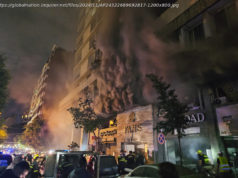Twin emergencies on two coasts this week — Hurricane Isaias and the Apple Fire — offer a preview of life in a warming world and the steady danger of overlapping disasters.
A low-grade hurricane that is slowly scraping along the East Coast. A wildfire in California that has led to evacuation orders for 8,000 people. And in both places, as well as everywhere between, a pandemic that keeps worsening. The daily morning briefing from the Federal Emergency Management Agency, usually a dry document full of acronyms and statistics, has begun to resemble the setup for a disaster movie. But rather than a freak occurrence, experts say that the pair of hazards bracketing the country this week offers a preview of life under climate change: a relentless grind of overlapping disasters, major or minor. The coronavirus pandemic has further exposed flaws in the nation’s defenses, including weak construction standards in vulnerable areas, underfunded government agencies, and racial and income disparities that put some communities at greater risk. Experts argue that the country must fundamentally rethink how it prepares for similar disasters as the effects of global warming accelerate. “State and local governments already stretched with Covid responses must now stretch even further,” said Lisa Anne Hamilton, adaptation program director at the Georgetown Climate Center in Washington. Better planning and preparation are crucial, she added, as the frequency and intensity of disasters increase. Hurricane Isaias made landfall in the Carolinas on Monday evening, its 75 mile-an-hour winds driving a storm surge as great as five feet. By Tuesday afternoon, downgraded to a tropical storm, Isaias had pushed north to the Mid-Atlantic states and the Northeast. Flash flooding was reported in Pennsylvania, and damaging winds left more than 1.2 million people in New Jersey and New York without power. The storm also spawned tornadoes, including one that killed two people in North Carolina. Isaias makes nine named storms in the Atlantic so far this year, something that has never before happened this early in the hurricane season, which runs from June 1 to Nov.30. Forecasters had predicted an active season, given warm ocean waters and other conditions, but 2020 is on track to be one of the busiest ever. It follows three years of devastating hurricanes, starting with Hurricane Harvey, Irma and Maria in 2017, then Florence and Michael in 2018 and Dorian in 2019. “Climate change is tough for people to grasp, but attribution studies continue to find its DNA in today’s tropical systems, heat waves, droughts and rainstorms,” said Marshall Shepherd, a professor of atmospheric sciences and geography at the University of Georgia and director of its atmospheric sciences program. For hurricanes, warmer oceans provide more energy, making them stronger. And warmer air holds more moisture, so the storms bring more rain. “Climate change shifts us into an era of sustained elevated risk from extreme weather and climate events,” Dr.
Home
United States
USA — Events Hurricane, Fire, Covid-19: Disasters Expose the Hard Reality of Climate Change






